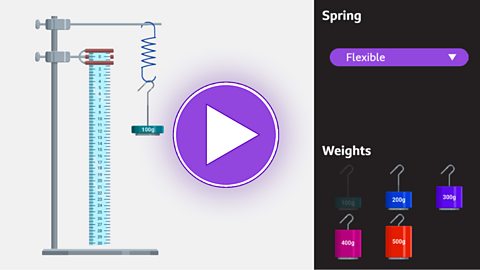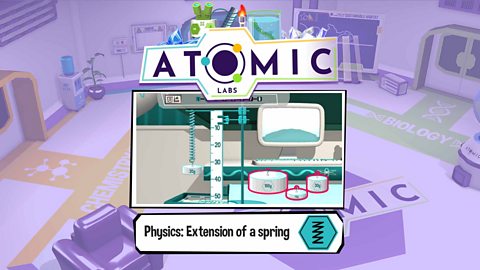Key Points
When a force is applied to an object it can change its size and shape.
The force will either stretch or compress the object. Some objects, like springs, obey Hooke’s law.
This law describes the relationship between the force applied and the spring’s extension or compression.
Hooke's law activity
Play this game to see what happens to springs when you add different weights, or change the strength of the spring.
Deformation
deformationWhen a force has been applied to an object to change its shape. occurs when we apply a force to an object to change its shape. Applying a force to an object can cause it to either:
stretch - the object increases in length
compress - the object decreases in length
In general, the greater the force applied, the more deformed an object will become.
However, not all materials behave in the same way. Elastic materials will return to their original shape once the force is removed, whereas inelastic materials will change shape permanently and may even break.
Hooke's law
When you apply a force to a material it can extend. The extensionThe difference between the length of an object before and after it has been stretched, measured in metres (m). is the amount the length has increased by.
More about Hooke's law
Watch the video of Brian Cox explaining Hooke's law.
Now forces don't just change the way that things move, they can also change the shape of things.
And a good example of that is Hooke's law. It says that if you apply a force to a spring, then the force stretches spring. And if you don't stretch too much, Hooke's law says that the amount of force you apply is proportional to the stretch.
So, that means that if you apply twice the force, you get twice the stretch. If you applied three times the force, you get three times the stretch.
Now, that works until you stretch the spring too much. Now, you probably know what happens if you overstretch a spring. It won't come back to its original shape, its original length.
Why is that? It's actually quite a nice and deep question with nice and deep answer.
It's because the spring is made up of lots of molecules that are all stuck together with their own little forces between them, and if you overstretch the spring you can break those bonds for good. They don't come back when you let go and so the spring doesn't come back to its original length.
So Hooke's law only applies if you keep all those bonds between the molecules together, that is to say, if you don't overstretch the spring.
Game - Hooke's law
Play an Atomic Labs experiment exploring Hooke's law.
You can also play the full game
Investigating Hooke's law
To investigate Hooke's LawThe extension of an elastic object is directly proportional to the force applied., you can add masses to a spring and measure the length of the spring when the weightA force that acts on mass, pulling it down, due to gravity. Weight is a force and forces are measured in newtons (N). of the masses is increased.
This experiment investigates Hooke's law.
Aim of the experiment
To investigate how adding massA measure of the amount of matter an object is made out of. Mass is measured in kilograms (kg). to a spring affects its extension.
Method
- Set up the apparatus as in the diagram below.
Add a 10 g mass to the holder and record the spring length.
Add another 10 g mass and record the new spring length.
Take away the previous spring length from the new length to calculate the extension (the difference).
Repeat by adding 10 g masses until 100 g is reached.
Variables
The independent variableThe factor which is deliberately changed in an investigation, to find out how it affects the dependent variable. is the mass (or the weight of the mass).
The dependent variableThe outcome of an investigation which is measured. is the extension.
control variableFactor in an investigation which are not being investigated but which might affect the outcome (the dependent variable). The control variables are things which must be kept the same whilst the independent variable is changed. include using the same spring for all the measurements.
Expected results
Remember to subtract the original length of the spring from each of your length measurements, so that you are recording the extensionThe difference between the length of an object before and after it has been stretched, measured in metres (m). of the spring, and not its total length.

Remember that to calculate the force applied to the spring due to the weight of the mass, you need to convert the mass in grams into kilograms (divide by 1000) and then multiply this mass by the gravitational field strength (10 N/kg), using this equation:
\(Weight = mass \times gravitational~field~strength \)
For example, the first mass added has a mass of 10 g. To convert this to kg, divide by 1000:
10 Ă· 1000 = 0.01
Now work out the weight:
\(Weight = mass \times gravitational~field~strength \)
\(weight = 0.01 \times 10\)
\(weight = 0.1~N\)
Record your results in a table
| Mass used (g) | Force (N) | Spring length (mm) | Extension (mm) |
|---|---|---|---|
| 0 | 0 | 20 | 0 |
| 10 | 0.1 | 25 | 5 (extension = spring length - original spring length) |
| 20 | 0.2 | 30 | 10 |
| 30 | 0.3 | 35 | 15 |
| 40 | 0.4 | 40 | 20 |
| 50 | 0.5 | 46 | 26 |
The spring extended 5 mm each time the force was increased by 0.1 N. This follows Hooke’s law which states that the extension of an elastic object (like a spring) is directly proportionalA relationship where if one value doubles, the other value also doubles. to the force added.
When the dependent variable is directly proportional to the independent variable, the graph will have a straight line that goes through the origin (0,0).
Elastic objects will usually obey Hooke’s law. However, some will also reach their elastic limit. This is where so much force has been applied that the object will no longer return to its original length when the force is removed and has been permanently deformed.
Try the experiment online
Try out this experiment in Atomic Labs. Go to the Physics lab and try the Extension of a spring experiment.
Atomic Labs game. gameAtomic Labs game
Try out practical experiments in this KS3 science game

Test your knowledge
Quiz - Multiple choice
Play the Atomic Labs game! gamePlay the Atomic Labs game!
Try out practical experiments in this KS3 science game.

More on Forces and movement
Find out more by working through a topic
- count12 of 16

- count13 of 16

- count15 of 16


